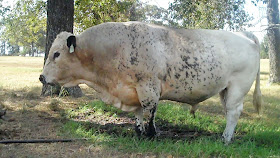I also found a very informative article on the Texas drought of 1984. I actually had no idea there had been one, but I wasn't much focused on rainfall in 1984. The drought of 1984 was severe and had devastating and long lasting consequences. Read "Dust to Dust", published in the Texas Monthly, October 1984, for an eye-opening hard truth in both words and photos of just how bad drought can be to a livestock producer.
The following weather observations are excerpts from:
Monthly Weather Review - By United States Army Signal Corps, United States, April 1887
 |
| J.West's S.S. Carter, (See Video clip) Standing over a Water Leak to get Cool, August 2011 |
DROUGHT: "Although rain accompanied the area of low that crossed Texas, the Indian Territory, and Kansas on the 18th, yet at the end of the month the long drought was practically unbroken, except in Kansas, where the rainfall of the 18th was quite heavy. In Texas the drought now extends from the western grazing country eastward to Louisiana, but decreases in severity as it approaches the eastern boundary. In central and eastern Texas, embracing the principal cotton-growing counties of the state, only a few light showers have fallen during the mouth."
The following notes are from observers:
"At San Antonio, Tex., although light rain fell on the 4th, 9th, 10th, 11th, 13th, 14th, and 16th, the total precipitation of the month was only 0.60 of an inch. Reports from adjoining counties indicate that their condition is even worse than the country immediately adjacent to San Antonio. The observer states that the dry grass from last year is exhausted, and as none has grown this spring the only forage for cattle is the prickly pear. Stock are dying rapidly. Numbers of families have deserted their homes and farms in search of a more favored locality. All hope of making the usual grain crop this season has been abandoned."
"New Ulm, Austin Co., Texas.: all interests are suffering from the drought; cattle are in need of grass and water; corn and cotton are in bad condition and will have to be replanted if rain falls. The normal April rainfall for this section, as deduced from the observations of the past fifteen years, is 3.84 inches; the total of the current month is only 0.17 inch, and is the least that has fallen in any April during that time. The normal rainfall of the seven months ending April 30th is 31.70 inches; the total amount of the corresponding months in 1880-'87 is 7.92, a deficiency of 23.78 inches. In 1873 eight inches of rain fell in April."
"Belleville, Republic Co., Kansas.: the first seventeen days of the month were remarkable for dry weather and the frequency and force of dust storms. On the 3rd and 9th, during wind storms, dust filled the air to such an extent that buildings one hundred feet distant were visible only at intervals. Independence, Montgomery Co., Kansas.: the first heavy rain in this section since September 4, 1886, fell on the 16th and 17th. On the 3rd, during a wind storm, the sky was obscured by dust."
"Salina, Salina Co., Kansas.: the month has been unusually dry, the total precipitation, 2.06 inches, being the least that has fallen in any April during the past five years."
"Grand Coteau, Saint Landry Parish, La.: the total amount of rainfall for the five months from December, 1880, to April, 1887, inclusive, 12.20 inches, is less than one-half of the normal amount; the soil is dry and crops late."
"Tucson, Arizona.: cattle are dying in large numbers from want of water and food; the Rillito River is dry for the first time in many years."
 |
| J.West's Bountiful Brigit Having a Drink from the Sprinkler, August 2011 |
"It should be noted that the period of observation is not sufficient to enable a perfectly satisfactory deduction, but it is plain that there has been a marked increase in precipitation during the last twenty years. The apparent falling off in the last five years is not unexpected, and does not indicate a permanent diminution, as it is mostly due to the small amount in 1886, and there have been four annual records previously, with a greater falling off than in 1886. We may conclude that the scarcity of rainfall in 1886 is not unprecedented, and that from past observations there is no proof of a permanent diminution in precipitation. Many more years' observations will be needed to establish a marked secular variation."
Well, there certainly have been many more years of observation, about 125 years of observation and recording of weather in the USA. This 1887 writer was no doubt right -- the scarcity of rainfall was not unprecedented -- and there was no permanent diminution in rainfall. Of course, a climate change fanatic or global warming guru might point to the increase in numbers of methane belching cattle in the prairies of Texas, Louisiana and the Indian Territory as the primary culprit of the 1886/1887 drought -- and claim it was without precedence, and the humble bovine has been bringing on brutal heat waves in Texas ever since!